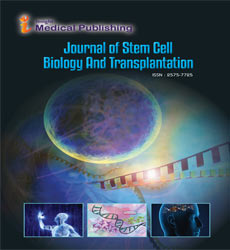ISSN : 2575-7725
Journal of Stem Cell Biology and Transplantation
Human Embryonic Stem Cells
Shibo Jin*
Newcastle University, Institute of Genetic Medicine, International Centre for Life, Central Parkway, Newcastle NE1 3BZ, UK
- *Corresponding Author:
- Shibo Jin
Newcastle University
Institute of Genetic Medicine
International Centre for Life
Central Parkway
Newcastle NE1 3BZ, UK
Tel: 07478585881
E-mail: s.jin@ncl.ac.uk
Received Date: November 04, 2016; Accepted Date: November 08, 2016; Published Date: November 15, 2016
Citation: Jin S. Human Embryonic Stem Cells. J. stem cell Bio. transplant. 2016, 1:1.
DOI: 10.21767/2575-7725.100003
Human embryonic stem cells (hES cells), which are derived from the inner cell mass (ICM) of early preimplantation human embryos, have two unique properties: unlimited self-renewal (ability to divide symmetrically to generate many undifferentiated cells under proper culture condition) and pluripotency (potential to give rise to any cell type of the adult organism). The first hES cell line was derived in 1998 by James A. Thomson at University of Wisconsin. Thereafter, many hES cell lines have been produced and characterized in a number of independent laboratories. In culture, hES cells grow in colonies; the cells have a high nuclear/cytoplasm ratio and expression of pluripotency markers, such as OCT4, NANOG, SOX2, LIN28 and POLR3G et al. The undifferentiated state of hES cells could be maintained by culturing hES cells on feeder cells (mouse embryonic fibroblast cells (MEF), human feeder cells) with hES media which contains bFGF, or on extracellular matrix (ECM, like matrigel or vitronectin) in medium which contains both bFGF and TGF.
hES cells and hiPS cells display also a very short G1 phase similarly to murine ES cells. In hES cells and hiPS cells, cell cycle duration is 15-16 h and G1 phase accounts for about 20% of the cell cycle. However, unlike mouse ES cells, Cyclins and CDKs show cell cycle dependent manner expression. The expression of Cdk4 is higher than Cdk6 in hES cells and human iPSCs compared with mouse ES cells. Furthermore, the expression of cell cycle inhibitors, INK and Cip/Kip family is almost undetectable.
MicroRNAs (miRNAs) are 20-25 nucleotides, endogenous noncoding RNAs. miRNA bind to its target mRNA can repress the translation process, miRNAs can also regulate mRNA degradation, mainly through deadenylation. miRNAs have an important function in regulating hES cell pluripotency. hES cell enriched miRNAs can be categorized into four major groups: miRNA from the miR-302 cluster, miRNAs from the miR-17 family, miRNAs from the miR-371-373 cluster, and miRNAs from chromosome 19 miRNA cluster. miRNAs also play roles in regulating hES cells cell cycle. For example, the miR-302 cluster can promote G1/S transition in hES cells.
So far the mechanism underlying the cell cycle regulation, selfrenewal and pluripotency of human pluripotent stem cells are not fully understood. Author research focused on miRNAs that are hES cell specific and changed during cell cycle transition are likely to have an impact in both maintenance of pluripotency and regulating cell cycle.
Open Access Journals
- Aquaculture & Veterinary Science
- Chemistry & Chemical Sciences
- Clinical Sciences
- Engineering
- General Science
- Genetics & Molecular Biology
- Health Care & Nursing
- Immunology & Microbiology
- Materials Science
- Mathematics & Physics
- Medical Sciences
- Neurology & Psychiatry
- Oncology & Cancer Science
- Pharmaceutical Sciences
